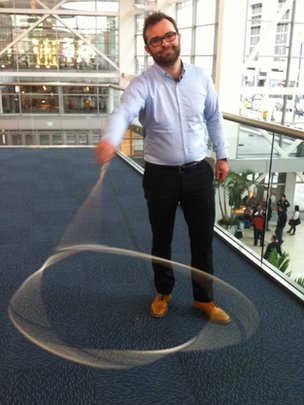
By James Morgan
From BBCnews.com
A maths equation for a spinning lasso stunt performed by cowboys and cowgirls has been unravelled.
By studying trick roping as a science, a French physicist has taught himself to lasso like a rodeo veteran.
Anyone can teach themselves the famous “flat loop” by following some basic formulae, says Dr Pierre-Thomas Brun, of EPFL in Switzerland.
He showed off his “cowboy physics” skills at the American Physical Society meeting in Denver.
Trick roping has evolved from a straightforward cattle-catching tool into a performance art form, seen in western movies and at Mexican charreadas – competitions featuring traditional horsemen (charros).
It was made famous by vaudeville cowboy Will Rogers in the 1920s and 1930s.
Flamboyant moves include the Merry-Go-Round, the Wedding Ring, and the Texas Skip – considered the most difficult.
But while these loops spellbind our imagination, they also harbour useful mathematical secrets.
“Elastic threads are everywhere in our daily lives – from hair and textile yarns to DNA and undersea broadband cables. Even the honey you pour on your toast,” said Dr Brun who worked on the research with his colleagues, Dr Basile Audoly and Dr Neil Ribe.
“All of these threads twist and coil according to the same equations as the cowboy’s lasso.”
Studying fancy tricks like “spoke-jumping” and the “Kansas Tornado” could actually help us unravel coiling problems which plague industries like yarn spinning.
To begin investigating, Dr Brun has created a mathematical recipe for the simplest trick – the flat loop.
“The physics boils down to a few simple rules,” he explained.
“First, use the maximum amount of rope in your loop – about 70%.
“Then, move your hands with a slow frequency – about two hertz.
“And crucially – with each turn of the rope, roll it between your thumb and forefinger, to avoid accumulating twist.”
Science and artistry
But is science really a good approach to learn trick roping?
BBC News spoke to “Cowboy Craig” Ingram, a champion roper who performs around Colorado.
“Absolutely, there’s a lot of science to trick roping: geometry, speed, timing and centrifugal forces,” he told BBC News.
“Cowboy Craig” Ingram performs a classic rope routine (Video courtesy of PT Brun)
“But it’s also more than science. It’s about artistry. When I perform it’s like dancing with a partner – I feel the fluidity of the rope spinning around me and I respond to its movements.”
Dr Brun agrees that, beyond the flat loop, the science quickly becomes more complicated.
“When Craig’s tricks get more fancy, you have to come up with a more dynamic model,” he explained.
“The flat loop equation is a simple, steady state solution. The rope is stationary in a reference frame that rotates with the hand. And exploiting this, we can derive a model in which line tension is balanced by the centrifugal force and the rope’s weight.
“But when you watch Craig’s routine – even in slow-motion – his stunts are way more gifted and skilled than our theories can follow at this point.”
To advance his model, he wishes to build a “robo-cowboy” that can self-adapt to the evolution of a spinning rope.
“With a robot, we can simulate more complex movements. And those could be of interest to the computer graphics industry – animation companies like Disney and Pixar,” he believes.
To animate a whirling skirt or the bounce of curly hair, you can follow similar equations to those governing the lasso, Dr Brun explains.
“The nice thing about physics, is we can apply maths to our favourite interests – like movies,” he says.
“As a child in France, I always enjoyed westerns. So I’m happy that as a scientist, I can explore the things that made me dream when I was young.”
Teach yourself the flat loop:
Use the maximum amount of rope in your loop – about 70%.
Move your hands with a slow frequency – about two hertz.
With each turn, roll the rope between your thumb and forefinger
